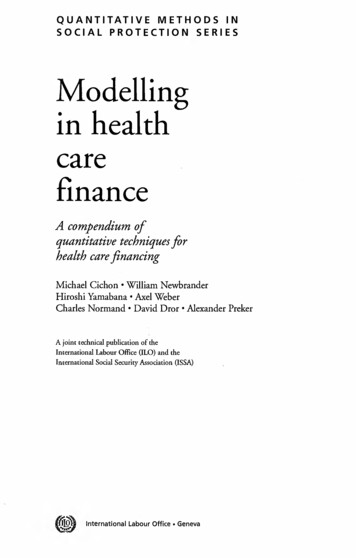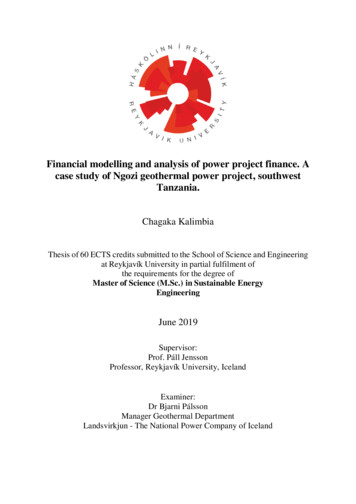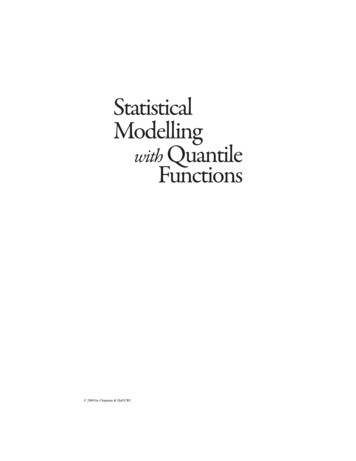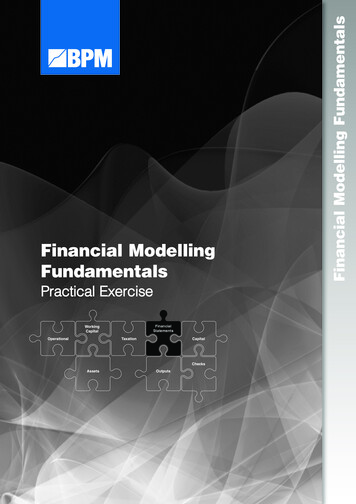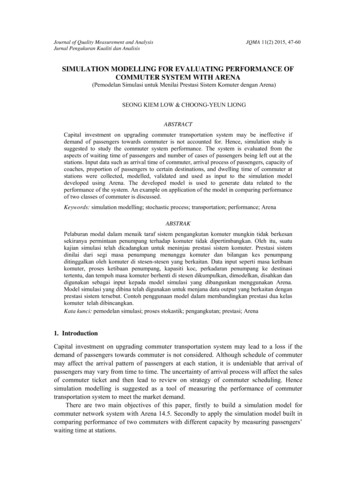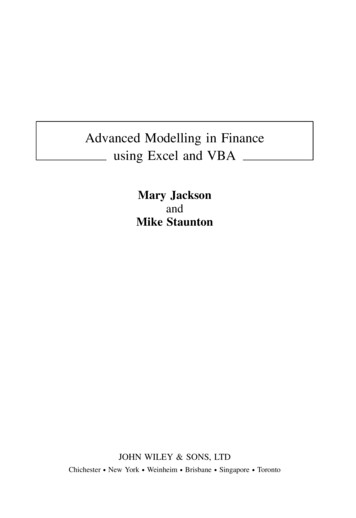
Transcription
Advanced Modelling in Financeusing Excel and VBAMary JacksonandMike StauntonJOHN WILEY & SONS, LTDChichesteržNew YorkžWeinheimžBrisbanežSingaporežToronto
Copyright 2001 by John Wiley & Sons, Ltd,Baffins Lane, Chichester,West Sussex PO19 1UD, EnglandNational01243 779777International (C44) 1243 779777e-mail (for orders and customer service enquiries): cs-books@wiley.co.ukVisit our Home Page on http://www.wiley.co.ukor http://www.wiley.comAll Rights Reserved. No part of this publication may be reproduced, stored in a retrievalsystem, or transmitted, in any form or by any means, electronic, mechanical, photocopying,recording, scanning or otherwise, except under the terms of the Copyright, Designs and Patents Act1988 or under the terms of a licence issued by the Copyright Licensing Agency, 90 Tottenham CourtRoad, London W1P 9HE, UK, without the permission in writing of the publisher.Other Wiley Editorial OfficesJohn Wiley & Sons, Inc., 605 Third Avenue,New York, NY 10158-0012, USAWiley-VCH Verlag GmbH, Pappelallee 3,D-69469 Weinheim, GermanyJohn Wiley & Sons Australia Ltd, 42 McDougall Street, Milton,Queensland 4064, AustraliaJohn Wiley & Sons (Asia) Pte Ltd, 2 Clementi Loop #02-01,Jin Xing Distripark, Singapore 129809John Wiley & Sons Canada Ltd, 6045 Freemont Blvd,Mississauga, ONT, L5R 4J3, CanadaBritish Library Cataloguing in Publication DataA catalogue record for this book is available from the British LibraryISBN 0 471 49922 6Typeset in 10/12pt Times by Laserwords Private Limited, Chennai, IndiaPrinted and bound in Great Britain by Bookcraft (Bath) Ltd, Midsomer–NortonThis book is printed on acid-free paper responsibly manufactured from sustainable forestry,in which at least two trees are planted for each one used for paper production.
ContentsPrefacexiAcknowledgementsxii1 Introduction1.1 Finance insights1.2 Asset price assumptions1.3 Mathematical and statistical problems1.4 Numerical methods1.5 Excel solutions1.6 Topics covered1.7 Related Excel workbooks1.8 Comments and suggestions112223355Part One Advanced Modelling in Excel72 Advanced Excel functions and procedures2.1 Accessing functions in Excel2.2 Mathematical functions2.3 Statistical functions2.3.1 Using the frequency function2.3.2 Using the quartile function2.3.3 Using Excel’s normal functions2.4 Lookup functions2.5 Other functions2.6 Auditing tools2.7 Data Tables2.7.1 Setting up Data Tables with one input2.7.2 Setting up Data Tables with two inputs2.8 XY charts2.9 Access to Data Analysis and Solver2.10 Using range names2.11 Regression2.12 Goal Seek9910121214151618192020222326272831
viContents2.13 Matrix algebra and related functions2.13.1 Introduction to matrices2.13.2 Transposing a matrix2.13.3 Adding matrices2.13.4 Multiplying matrices2.13.5 Matrix inversion2.13.6 Solving systems of simultaneous linear equations2.13.7 Summary of Excel’s matrix functionsSummary3333333434353637373 Introduction to VBA3.1 Advantages of mastering VBA3.2 Object-oriented aspects of VBA3.3 Starting to write VBA macros3.3.1 Some simple examples of VBA subroutines3.3.2 MsgBox for interaction3.3.3 The writing environment3.3.4 Entering code and executing macros3.3.5 Recording keystrokes and editing code3.4 Elements of programming3.4.1 Variables and data types3.4.2 VBA array variables3.4.3 Control structures3.4.4 Control of repeating procedures3.4.5 Using Excel functions and VBA functions in code3.4.6 General points on programming3.5 Communicating between macros and the spreadsheet3.6 Subroutine examples3.6.1 Charts3.6.2 Normal probability plot3.6.3 Generating the efficient frontier with SolverSummaryReferencesAppendix 3A The Visual Basic EditorStepping through a macro and using otherdebug toolsAppendix 3B Recording keystrokes in ‘relative references’ 6568694 Writing VBA user-defined functions4.1 A simple sales commission function4.2 Creating Commission(Sales) in the spreadsheet4.3 Two functions with multiple inputs for valuing options4.4 Manipulating arrays in VBA4.5 Expected value and variance functions with array inputs4.6 Portfolio variance function with array inputs4.7 Functions with array output4.8 Using Excel and VBA functions in user-defined functions737374757879818485
Contents4.94.8.1 Using VBA functions in user-defined functions4.8.2 Add-insPros and cons of developing VBA functionsSummaryAppendix 4A Functions illustrating array handlingAppendix 4B Binomial tree option valuation functionsExercises on writing functionsSolution notes for exercises on functionsPart TwoEquitiesvii8586868788899495995 Introduction to equities1016 Portfolio optimisation6.1 Portfolio mean and variance6.2 Risk–return representation of portfolios6.3 Using Solver to find efficient points6.4 Generating the efficient frontier (Huang and Litzenberger’sapproach)6.5 Constrained frontier portfolios6.6 Combining risk-free and risky assets6.7 Problem One–combining a risk-free asset with a risky asset6.8 Problem Two–combining two risky assets6.9 Problem Three–combining a risk-free asset with a risky portfolio6.10 User-defined functions in Module16.11 Functions for the three generic portfolio problems in Module16.12 Macros in ModuleMSummaryReferences1031031051067 Asset7.17.27.37.47.57.67.77.8pricingThe single-index modelEstimating beta coefficientsThe capital asset pricing modelVariance–covariance matricesValue-at-RiskHorizon wealthMoments of related distributions such as normal and lognormalUser-defined functions in Module1SummaryReferences8 Performance measurement and attribution8.1 Conventional performance measurement8.2 Active–passive management8.3 Introduction to style 129130131134136136138138139140141144
viiiContents8.48.58.68.78.8Simple style analysisRolling-period style analysisConfidence intervals for style weightsUser-defined functions in Module1Macros in ModuleMSummaryReferences145146148151151152153Part Three Options on 6Introduction to options on equities9.1 The genesis of the Black–Scholes formula9.2 The Black–Scholes formula9.3 Hedge portfolios9.4 Risk-neutral valuation9.5 A simple one-step binomial tree with risk-neutral valuation9.6 Put–call parity9.7 Dividends9.8 American features9.9 Numerical methods9.10 Volatility and non-normal share returnsSummaryReferences10 Binomial trees10.1 Introduction to binomial trees10.2 A simplified binomial tree10.3 The Jarrow and Rudd binomial tree10.4 The Cox, Ross and Rubinstein tree10.5 Binomial approximations and Black–Scholes formula10.6 Convergence of CRR binomial trees10.7 The Leisen and Reimer tree10.8 Comparison of CRR and LR trees10.9 American options and the CRR American tree10.10 User-defined functions in Module0 and 818018218318411 The Black–Scholes formula11.1 The Black–Scholes formula11.2 Black–Scholes formula in the spreadsheet11.3 Options on currencies and commodities11.4 Calculating the option’s ‘greek’ parameters11.5 Hedge portfolios11.6 Formal derivation of the Black–Scholes formula185185186187189190192
Contentsix11.7 User-defined functions in Module1SummaryReferences19419519612Other numerical methods for European options12.1 Introduction to Monte Carlo simulation12.2 Simulation with antithetic variables12.3 Simulation with quasi-random sampling12.4 Comparing simulation methods12.5 Calculating greeks in Monte Carlo simulation12.6 Numerical integration12.7 User-defined functions in 720713Non-normal distributions and implied volatility13.1 Black–Scholes using alternative distributional assumptions13.2 Implied volatility13.3 Adapting for skewness and kurtosis13.4 The volatility smile13.5 User-defined functions in rt FourOptions on Bonds22114Introduction to valuing options on bonds14.1 The term structure of interest rates14.2 Cash flows for coupon bonds and yield to maturity14.3 Binomial trees14.4 Black’s bond option valuation formula14.5 Duration and convexity14.6 3015Interest rate models15.1 Vasicek’s term structure model15.2 Valuing European options on zero-coupon bonds, Vasicek’s model15.3 Valuing European options on coupon bonds, Vasicek’s model15.4 CIR term structure model15.5 Valuing European options on zero-coupon bonds, CIR model15.6 Valuing European options on coupon bonds, CIR model15.7 User-defined functions in 0241
xContents16 Matching the term structure16.1 Trees with lognormally distributed interest rates16.2 Trees with normal interest rates16.3 The Black, Derman and Toy tree16.4 Valuing bond options using BDT trees16.5 User-defined functions in pendix Other VBA functionsForecastingARIMA modellingSplinesEigenvalues and eigenvectorsReferences253253254256257258Index259
PrefaceWhen asked why they tackled Mount Everest, climbers typically reply “Because it wasthere”. Our motivation for writing Advanced Modelling in Finance is for exactly theopposite reason. There were then, and still are now, almost no books that give dueprominence to and explanation of the use of VBA functions within Excel. There is analmost similar lack of books that capture the true vibrant spirit of numerical methodsin finance.It is no longer true that spreadsheets such as Excel are inadequate tools in highly technical and numerically demanding areas such as the valuation of financial derivatives. Withefficient code and VBA functions, calculations that were once the preserve of dedicatedpackages and languages can now be done on a modern PC in Excel within seconds, ifnot fractions of a second. By employing Excel and VBA, our purpose is to try to bringclarity to an area that was previously covered with black boxes.What started as an attempt to push back the boundaries of Excel through macros turnedinto a full-scale expedition into the VBA language within Excel and then developed fromequities, through options and finally to cover bonds. Along the way we learned scores ofnew Excel skills and a much greater understanding of the numerical methods implementedacross finance.The genesis of the book came from material developed for the ‘Computer-Based Financial Modelling’ elective on the MBA degree at London Business School. The part onequities formed the basis for an executive course on ‘Equity Portfolio Management’ runannually by the International Centre for Money and Banking in Geneva. The parts onoptions and bonds comprise a course in ‘Numerical Methods’ on the MSc in Mathematical Trading and Finance at City University Business School. The book is within the reachof both students at the postgraduate level and those in the latter undergraduate years.There are no prerequisites for readers apart from a willingness to adopt a pro-activestance when using the book–namely by taking advantage of the inherent ‘what-if’ qualityof the spreadsheets and by looking at and using the code forming the VBA user-definedfunctions. Since we assume for the most part that asset returns are lognormal and thereforeuse binomial trees as a central numerical method, our explanations can be based onfamiliar results from probability and statistics. Comprehension is helped by the use of acommon notation throughout, and transparency by the availability of complete solutionsin both Excel and VBA forms.
AcknowledgementsOur main debt is to the individuals from the academic and practitioner communities infinance who first developed the theory and then the numerical methods that form thematerial for this book. In the words of Sir Isaac Newton “If I have seen further it is bystanding on the shoulders of giants”.We would also like to thank our colleagues at both London Business School and CityUniversity Business School, in particular Elroy Dimson, John Hatgioannides, Paul Marshand Kiriakos Vlahos.We would like to thank Sam Whittaker at Wiley for her enthusiasm, encouragementand much needed patience, invaluable qualities for an editor.Last but not least, we are grateful for the patience of family and friends who haveoccasionally chivvied us about the book’s somewhat lengthy gestation period.
1IntroductionWe hope that our text, Advanced Modelling in Finance, is conclusive proof that a widerange of models can now be successfully implemented using spreadsheets. The modelsrange across the complete spectrum of finance including equities, equity options and bondoptions spanning developments from the early fifties to the late nineties. The models areimplemented in Excel spreadsheets, complemented with functions written using the VBAlanguage within Excel. The resulting user-defined functions provide a portable library ofprograms with more than sufficient speed and accuracy.Advanced Modelling in Finance should be viewed as a complement (or dare we say,an antidote) to traditional textbooks in the area. It contains relatively few derivations,allowing us to cover a broader range of models and methods, with particular emphasison more recent advances.The major theoretical developments in finance such as portfolio theory in the 1950s,the capital asset pricing model in the 1960s and the Black–Scholes formula in the 1970sbrought with them analytic solutions that are now straightforward to calculate. The subsequent decades have seen a growing body of developments in numerical methods. With anintelligent choice of parameters, binomial trees have assumed a central role in the morenumerically-intensive calculations now required to value equity and bond options. Thecentre of gravity in finance now concerns the search for more efficient ways of performingsuch calculations rather than the theories from yesteryear.The breadth of the coverage across finance and the sophistication needed for someof the more advanced models are testament to the ability of Excel, the built-in functionscontained in Excel and the real programming environment that VBA provides. This allowsus to highlight the commonality of assumptions (lognormality), mathematical problems(expectation) and numerical methods (binomial trees) throughout finance as a whole.Without exception, we have tried to ensure a consistent and simple notation throughoutthe book to reinforce this commonality and to improve clarity of exposition.Our objective in writing a book that covers the broad range of subjects in financehas proved to be both a challenge and an opportunity. The opportunity has providedus with the chance to overview finance as a whole and, in so doing, to make important connections and bring out commonalities in asset price assumptions, mathematical problems, numerical methods and Excel solutions. In the following sections wesummarise a few of these unifying insights that apply to equities, options and bondswith regard to finance, mathematical topics, numerical methods and Excel features. Thisis followed by a more detailed summary of the main topics covered in each chapter ofthe book.1.1 FINANCE INSIGHTSThe genesis of modern finance as a subject separate from economics started withMarkowitz’s development of portfolio theory in 1952. Markowitz used utility theory tomodel the preferences of individual investors and to develop a mean–variance approach
2Advanced Modelling in Financeto examining the trade-off between return (as measured by an asset’s mean return) andrisk (measured by an asset’s variance of return). This subsequently led to the developmentby Sharpe, Lintner and Treynor of the capital asset pricing model (CAPM), an equilibriummodel describing expected returns on equities. The CAPM introduced beta as a measureof diversifiable risk, arguing that the creation of portfolios served to minimise the specificrisk element of total risk (variance).The next great theoretical development was the equity option pricing formula of Blackand Scholes, which rested on the ability to create a (riskless) hedge portfolio. Contemporaneously, Merton extended the Black–Scholes formula to allow for continuous dividendsand thus also options on commodities and currencies. The derivation of the originalformula required the solving of the diffusion (or heat) equation familiar from physics, butwas subsequently encompassed by the broader risk-neutral approach to the valuation ofderivatives.1.2 ASSET PRICE ASSUMPTIONSAlthough portfolio theory was derived through individual preferences, it could also havebeen obtained by making assumptions about the distribution of asset price returns. Thestandard assumption is that equity returns follow a lognormal distribution–equivalently wecan say that equity log returns follow a normal distribution. More recently, practitionershave examined the effect of departures from strict normality (as measured by skewnessand kurtosis) and have also proposed different distributions (for example, the reciprocalgamma distribution).Although bonds have characteristics that are different from equities, the starting pointfor bond option valuation is the short interest rate. This is frequently assumed to followthe lognormal or normal distribution. The result is that familiar results grounded in theseprobability distributions can be applied throughout finance.1.3 MATHEMATICAL AND STATISTICAL PROBLEMSWithin the equities part, the mathematical problems concern optimisation. The optimisation can also include additional constraints, exemplified by Sharpe’s development ofreturns-based style analysis. Beta is estimated as the slope coefficient in a linear regression.Options are valued in the risk-neutral framework as statistical expectations. The normaldistribution of log equity prices can be approximated by an equivalent discrete binomial distribution. This binomial distribution provides the framework for calculating theexpected option value.1.4 NUMERICAL METHODSIn the context of portfolio optimisation, the optimisation involves portfolio variance, andthe numerical method needed for optimisation is quadratic programming. Style analysisalso uses quadratic programming, the quantity to be minimised being the error variance.Although not usually thought of as optimisation, linear regression chooses slope coefficients to minimise residual error. Here optimisation is of a different kind, regressionanalysis, which provides analytical formulas to calculate the beta coefficients.Turning to option valuation, the binomial tree provides the structure within whichthe risk-neutral expectation can be calculated. We highlight the importance of parameter
Introduction3choice by examining the convergence properties of three different binomial trees. Suchtrees also allow the valuation of American options, where the option can be exercised atany date prior to maturity.With European options, techniques such as Monte Carlo simulation and numericalintegration are also used. Numerical search methods, in particular the Newton–Raphsonapproach, ensure that volatilities implied by option prices in the market can be estimated.1.5 EXCEL SOLUTIONSThe spreadsheets demonstrate how Excel can be used as a prototype for building models.Within the individual spreadsheets, all the formulas in the cells can easily be examinedand we have endeavoured to incorporate all intermediate calculations in cells of theirown. The spreadsheets also allow the hallmark ability to ‘what-if’ by changing parametervalues in cells.The implementation of all the models and methods occurs twice: once in the spreadsheets and once in the VBA functions. This dual approach serves as an important checkon the accuracy of the numerical calculations.Some of the VBA procedures are macros, normally seen by others as the main purposeof VBA in Excel. However, the majority of the procedures we implement are user-definedfunctions. We demonstrate how easily these functions can be written in VBA and howthey can incorporate Excel functions, including the powerful matrix functions.The Goal Seek and Solver commands within Excel are used in the optimisation tasks.We show how these commands can be automated using VBA user-defined functions andmacros. Another under-used aspect of Excel involves the application of array functions(invoked by the CtrlCShiftCEnter keystroke combination) and we implement these inuser-defined functions. To improve efficiency, our binomial trees in user-defined functionsuse one-dimensional arrays (vectors) rather than two-dimensional arrays (matrices).1.6 TOPICS COVEREDThere are four parts in the book, the first part illustrating the advanced modelling featuresin Excel followed by three parts with applications in finance. The three parts on applications cover equities, options on equities and options on bonds.Chapter 2 emphasises the advanced Excel functions and techniques that we use in theremainder of the book. We pay particular attention to the array functions within Exceland provide a short section detailing the mathematics underlying matrix manipulation.Chapter 3 introduces the VBA programming environment and illustrates a step-by-stepapproach to the writing of VBA subroutines (macros). The examples chosen demonstratehow macros can be used to automate and repeat tasks in Excel.Chapter 4 moves on to VBA user-defined functions, which have a crucial rolethroughout the applications in finance. We emphasise how to deal with both scalarand array variables–as input variables to VBA functions, their use in calculations andfinally as output variables. Again, we use a step-by-step approach for a number ofexamples. In particular, we write user-defined functions to value both European options(the Black–Scholes formula) and American options (binomial trees).Chapter 5 introduces the first application part, that dealing with equities.Chapter 6 covers portfolio optimisation, using both Solver and analytic solutions. Aswill become the norm in the remaining chapters, Solver is used both in the spreadsheet
4Advanced Modelling in Financeand automated in a VBA macro. By using the array functions in Excel and VBA, we detailhow the points on the efficient frontier can be generated. The development of portfoliotheory is divided into three generic problems, which recur in subsequent chapters.Chapter 7 looks at (equity) asset pricing, starting with the single-index model andthe capital asset pricing model (CAPM) and concluding with Value-at-Risk (VaR). Thisintroduces the assumption that asset log returns follow a normal distribution, anotherrecurrent theme.Chapter 8 covers performance measurement, again ranging from single-parametermeasures used in the very earliest days to multi-index models (such as style analysis) thatrepresent current best practice. We show, for the first time in a textbook, how confidenceintervals can be determined for the asset weights from style analysis.Chapter 9 introduces the second application part, that dealing with options on equities.Building on the normal distribution assumed for equity log returns, we detail the creationof the hedge portfolio that is the key insight behind the Black–Scholes option valuationformula. The subsequent interpretation of the option value as the discounted expectedvalue of the option payoff in a risk-neutral world is also introduced.Chapter 10 looks at binomial trees, which can be viewed as a discrete approximation to the continuous normal distribution assumed for log equity prices. In practice,binomial trees form the backbone of numerical methods for option valuation since theycan cope with early exercise and hence the valuation of American options. We illustratethree different parameter choices for binomial trees, including the little-known Leisen andReimer tree that has vastly superior convergence and accuracy properties compared to thestandard parameter choices. We use a nine-step tree in our spreadsheet examples, but theuser-defined functions can cope with any number of steps.Chapter 11 returns to the Black–Scholes formula and shows both its adaptability(allowing options on assets such as currencies and commodities to be valued) and itsdependence on the asset price assumptions.Chapter 12 covers two alternative ways of calculating the statistical expectation thatlies behind the Black–Scholes formula for European options. These are Monte Carlosimulation and numerical integration. Although these perform less well for the simpleoptions we consider, each of these methods has a valuable role in the valuation of morecomplicated options.Chapter 13 moves away from the assumption of strict normality of asset log returns andshows how such deviation (typically through differing skewness and kurtosis parameters)leads to the so-called volatility smile seen in the market prices of options. Efficientmethods for finding the implied volatility inherent in European option prices are described.Chapter 14 introduces the third application part, that dealing with options on bonds.While bond prices have characteristics that are different from equity prices, there is alot of commonality in the mathematical problems and numerical methods used to valueoptions. We define the term structure based on a series of zero-coupon bond prices, andshow how the short-term interest rate can be modelled in a binomial tree as a means ofvaluing zero-coupon bond cash flows.Chapter 15 covers two models for interest rates, those of Vasicek and Cox, and Ingersolland Ross. We detail analytic solutions for zero-coupon bond prices and options on zerocoupon bonds together with an iterative approach to the valuation of options on couponbonds.Chapter 16 shows how the short rate can be modelled in a binomial tree in orderto match a given term structure of zero-coupon bond prices. We build the popular
Introduction5Black–Derman–Toy interest rate tree (both in the spreadsheet and in user-defined functions) and show how it can be used to value both European and American options onzero-coupon bonds.The final Appendix is a Pandora’s box of other user-defined functions, that are less relevant to the chosen applications in finance. Nevertheless they constitute a useful toolbox,including as they do functions for ARIMA modelling, splines, eigenvalues and othercalculation procedures.1.7 RELATED EXCEL WORKBOOKSPart I which concentrates on Excel functions and procedures and understanding VBA hasthree related workbooks, AMFEXCEL, VBSUB and VBFNS which accompany Chapters 2, 3 and 4 respectively.Part II on equities has three related workbooks, EQUITY1, EQUITY2 and EQUITY3which accompany Chapters 6, 7 and 8 respectively.Part III on options on equities has four files, OPTION1, OPTION2, OPTION3 andOPTION4 which accompany Chapters 10, 11, 12 and 13 respectively.Part IV on bonds has two related workbooks, BOND1 and BOND2 which accompanyChapters 14, 15 and 16 as indicated in the text.The Appendix has one workbook, OTHERFNS.1.8 COMMENTS AND SUGGESTIONSHaving spent so much time developing the material and writing this book, we would verymuch appreciate any comments, suggestions and, dare we say, possible corrections andimprovements. Please email mstaunton@london.edu or find your way to www.london.edu/ifa/services/services.html or www.business.city.ac.uk/irmi/mstaunton.html.
Part OneAdvanced Modelling in Excel
2Advanced Excel Functions and ProceduresThe purpose of this chapter is to review certain Excel functions and procedures usedin the text. These include mathematical, statistical and lookup functions from Excel’sextensive range of functions, as well as much-used procedures such as setting up DataTables and displaying results in XY charts. Also included are methods of summarisingdata sets, conducting regression analyses, and accessing Excel’s Goal Seek and Solver.The objective is to clarify and ensure that this material causes the reader no difficulty.The advanced Excel user may wish to skim the content or use the chapter for furtherreference as and when required. To make the various topics more entertaining and moreinteractive, a workbook AMFEXCEL.xls includes the examples discussed in the text andallows the reader to check his or her proficiency.2.1 ACCESSING FUNCTIONS IN EXCELExcel provides many worksheet functions, which are essentially calculation routines thathave been coded up. They are useful for simplifying calculations performed in the spreadsheet, and also for combining into VBA macros and user-defined functions (topics coveredin Chapters 3 and 4).The Paste Function button (labelled fx) on the standard toolbar gives access to them. (Itwas previously known as the function wizard.) As Figure 2.1 shows, functions are groupedinto different categories: mathematical, statistical, logical, lookup and reference, etc.Figure 2.1 Paste Function dialog box showing the COMBIN function in the Math category
10Advanced Modelling in FinanceHere the Math & Trig function COMBIN has been selected, which produces a briefdescription of the function’s inputs and outputs. For a fuller description, press the Helpbutton (labelled ?).On clicking OK, the Formula palette appears providing slots for entering the appropriateinputs, as in Figure 2.2. The required inputs can be keyed into the slots (as here) or‘selected’ by referencing cells in the spreadsheet (by clicking the buttons to collapse theFormula palette). Note that the palette can be dragged away from its standard position.Clicking the OK button on the palette or the tick on the Edit line enters the formula inthe spreadsheet.Figure 2.2 Building the COMBIN function in the Formula paletteAs well as the Formula palette with inputs for function COMBIN, Figure 2.2 shows theconstruction of the cell formula on the Edit line, with the Paste Function button depressed(in action). Notice also the Paste Name button (labelled Dab) which facilitates pasting ofnamed cells into the formula. (Attaching names to ranges and referencing cell ranges bynames is reviewed in section 2.10.)As well as all Excel functions, the Paste Function button also provides access to theuser-defined category of functions which
2.13.7 Summary of Excel's matrix functions 37 Summary 37 3 Introduction to VBA 39 3.1 Advantages of mastering VBA 39 3.2 Object-oriented aspects of VBA 40 3.3 Starting to write VBA macros 42 3.3.1 Some simple examples of VBA subroutines 42 3.3.2 MsgBox for interaction 43 3.3.3 The writing environment 44 3.3.4 Entering code and executing macros 44

